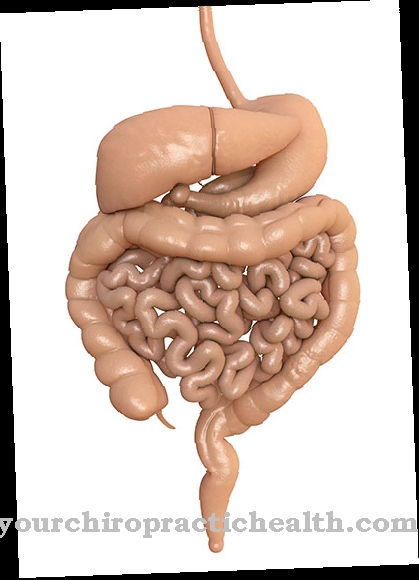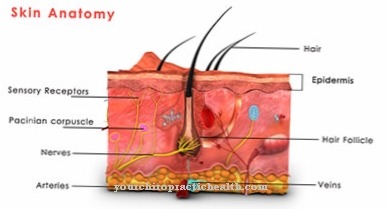In the Ectrodactyly it is a deformity of the skeleton on the hands or feet. The disease is often genetic and has been present in the affected person since birth. In the context of ectrodactyly, the sick patients have mutilations of the fingers or feet. In numerous cases, fingers or individual toes are missing. This often gives the appearance of a so-called split hand or split foot.
What is ectrodactyly?

© apple meanwhile - stock.adobe.com
In many cases, ectrodactyly is genetically caused and is associated with various syndromes. This shows, for example, associations with malformations of the eyes, nystagism and Karsch-Neugebauer syndrome. It is also possible that ectrodactyly occurs together in the context of Gollop-Wolfgang syndrome, with a femur bifurcation and hand ectrodactyly showing on one side.
There are also connections to Jancar syndrome and the so-called ADULT syndrome. It is an abnormality in the anatomy of the skeleton of the feet or hands that is relatively rare. The prevalence of ectrodactyly ranges from 1: 1,000,000 to 9: 1,000,000. There are different types of inheritance of the disease and different forms of ectrodactyly that are not related to syndromes.
Ectrodactyly sometimes occurs as a single symptom. The ectrodactyly is synonymous by some medical professionals as Split hand split foot malformation designated. The so-called central rays of the hands and feet are primarily affected by the deformation.
causes
Ectrodactyly forms as a result of various triggers. Depending on the patient, different factors are responsible for the development of the anomaly. As a rule, ectrodactyly is a genetic disease. This means that mutations on special genes are responsible for the genesis of the disease.
In such cases, symptoms persist from birth. According to the current state of medical research, five gene locations are known whose mutations cause ectrodactyly. The inheritance is either autosomal-dominant or X-linked recessive.
Symptoms, ailments & signs
Ectrodactyly shows various symptoms, but all of them are very typical for the disease. Usually the affected patients have a combination of syndactyly and oligodactyly, with the feet or hands having a central cleft. For this reason, the diseased hands or feet of the affected people are reminiscent of the claws of crabs in their visual appearance.
The two parts next to the middle column can be opposed to each other. The typical malformations sometimes only show up on one hand or one foot. In some cases, however, all extremities are affected by the malformations.
Syndactyly in connection with what is known as oligodactyly results in a crab claw hand. There is a clear central cleft on the affected hands or feet.In some cases, ectrodactyly is associated with aniridia, hearing loss and Alport's syndrome.
diagnosis
If, due to characteristic signs of the disease, the presence of ectrodactyly is suspected, medical advice is required. Affected people first contact their general practitioner. He or she will refer the patient to a specialist doctor as required.
The first step in making the diagnosis is always a conscientious anamnesis, which the treating doctor carries out with the sick person. The patient is asked to describe his symptoms as well as the circumstances and time at which the symptoms began as precisely as possible. In addition, the doctor analyzes the lifestyle of each person in order to get an idea of potential risk factors.
In the case of genetic diseases such as ectrodactyly, the family history also plays a decisive role. If cases of illness have already emerged in the family, the suspicion of the illness is reinforced. As soon as the patient interview is completed, the attending physician conducts a series of clinical examinations.
Since ectrodactyly is a deformity of the skeleton, diagnostic imaging methods are primarily used. Usually, the doctor will perform x-ray examinations of the affected hands and feet. The characteristic malformations of the bone anatomy are usually already clearly recognizable. The diagnosis of ectrodactyly can be made relatively certain by means of a genetic analysis of the sick person. Because in this way the mutations on the known gene loci can be detected.
Complications
Patients with ectrodactyly mainly suffer from various malformations of the feet and fingers. Because of this malformation, children in particular are teased or bullied. The patient's mobility is severely restricted, and in many cases it is not possible to use the fingers in a normal way, which leads to restrictions in everyday life.
The quality of life is also greatly reduced by ectrodactyly. However, it cannot be predicted whether all extremities will be affected by the malformations. Often those affected also suffer from a hearing loss and are therefore dependent on a hearing aid in everyday life. In the case of severe malformations, it is often not possible for the patient to cope with everyday life alone, so that he or she has to rely on the help of other people.
The restricted freedom of movement can lead to depression in many people. Many malformations can be corrected through surgery. It is also possible to use prostheses. This means that there are no further complications and the quality of life of the person affected is increased again. Therapy can also restore motor skills.
When should you go to the doctor?
As a rule, ectrodactyly is diagnosed before or immediately after the birth. For this reason, an additional diagnosis is no longer necessary in most cases. However, the person affected should then consult a doctor if the malformations on the skeleton lead to various complaints and restrictions in the patient's everyday life. If the symptoms are treated at an early stage, they can usually be limited.
A visit to the doctor is especially necessary if the development of the child is disturbed or significantly delayed by the ectrodactyly. Unfortunately, this disease often leads to teasing or bullying, so a visit to a psychologist is advisable. Furthermore, a doctor should also be consulted if the patient has a hearing loss.
As a rule, the symptoms are relieved by surgical interventions. These take place in a hospital. The hearing loss can usually be treated by an ENT doctor with the help of a hearing aid. However, the patients are still dependent on regular medical examinations.
Doctors & therapists in your area
Treatment & Therapy
There are various options for the therapy of ectrodactyly available, which are used depending on the individual case. The typical malformations of the hands or feet can be corrected in the course of surgical interventions. Prostheses may also be used to improve hand and foot functions.
In many cases, however, there is no need to treat or correct ectrodactyly from a functional perspective. Because despite the ectrodactyly, many patients have a high degree of mobility of their hands and feet as well as sufficient motor skills to cope with their everyday life independently. In principle, a medical check-up makes sense.
Outlook & forecast
Ectrodactyly can usually be treated with surgery. The prospect of recovery is good if the patient has the necessary surgical interventions performed early. If the disease is only treated in adolescence or adulthood, misalignments, joint wear and other complications have usually already developed.
These can be treated symptomatically, for example with pain relievers and other surgical interventions. However, if the treatment is delayed, there are always complaints that permanently limit the quality of life and well-being of the person concerned.
Life expectancy is not reduced by a single ectrodactyly. However, the malformations increase the risk of diseases of the vessels, joints and bones, for example circulatory disorders or infections. The malformations are also perceived by those affected as a visual flaw and can cause psychological complaints. Therapy can reduce depressive moods and other mental ailments and thereby improve the prognosis.
If the disease occurs in combination with other malformation syndromes such as Karsch-Neugebauer syndrome or femur bifurcation, the prognosis is worse. Often there are further complaints of the organs or joints, which progressively progress and reduce life expectancy. The responsible doctor can make a final prognosis, who will consider the course of the disease and any risk factors.
prevention
In the majority of cases, ectrodactyly is a congenital disease that is caused by gene mutations. In principle, the disease cannot be effectively prevented. Numerous medical studies are currently working on research into practicable ways of preventing genetic diseases.
Aftercare
In most cases, ectrodactyly requires proper treatment from a doctor. Since this is a hereditary disease, the measures or options for follow-up care are very limited. The person concerned is therefore primarily dependent on the rapid detection and treatment of the disease so that there are no further complaints or complications.
A doctor should therefore be consulted at the first signs of ectrodactyly. If the patient wishes to have children, genetic counseling or diagnosis can also be carried out in order to prevent ectrodactyly from being passed on to the descendants. It cannot be universally predicted whether the disease will lead to a reduced life expectancy for the person affected.
In general, loving care and support for the person affected has a positive effect on the course of the disease. Most patients are dependent on the help of their fellow human beings in everyday life. Contact with other affected people can also be useful and lead to an exchange of information. In addition, physiotherapy can prove to be useful to increase the mobility of the joints again.
You can do that yourself
Ectrodactyly is a congenital disease in the vast majority of cases. Patients cannot take any action to treat the cause. Those affected should ensure that they or their child are looked after by a specialist.
Very often those affected have no problems coping with everyday life, even if they suffer from deformities of the hands and feet. However, the malformations have a disfiguring effect and therefore lead to psychological and social problems. In addition, many patients have limited mobility or the ability to grip so that everyday movements cannot be performed or writing cannot be learned.
In these cases, those affected should definitely clarify with a specialist whether the malformations can be corrected or at least improved by surgical intervention. Even if the motor skills are not impaired, a purely cosmetic intervention may be advisable if the person concerned suffers severely mentally from the malformation and the associated disfigurement.
Psychotherapy can also be helpful in these cases. Parents of affected children, who are often teased or bullied by their peers, should seek psychological support in good time to prevent late damage.



.jpg)









.jpg)

.jpg)
.jpg)











.jpg)